- Book Review: Agricultural and Horticultural Seeds
- Book Review: Cornucopia: A Source Book of Edible Plants
- Are Free Seeds a Good Idea?
- Seeds for the Americas
- Saving Seeds from Hybrids
- Bamboo Breeding
- Where Can I Find Seed for Breadfruit?
- How to Produce Carrot Seed Where Winters Are Not Cold
- How Far Apart Must Corn Be Kept to Prevent Cross-Pollination by Other Local Varieties?
- Growing Garlic
- Saving Your Own Lettuce Seed
- Onion Variety Trial
- The Solo Papayas Are Great, But...
- Malaysia Exotica Papaya Seed
- Why Is There Such High Turnover in the Tree Seed Business?
- Roy Danforth and Paul Noren's Tropical Fruit Tree Project in Zaire
- More Seed Sources
AGRICULTURAL AND HORTICULTURAL SEEDS. We turn to this useful 531-page book by the Food and Agriculture Organization to answer such questions as whether one of you can produce your own onion or cabbage or tomato seed in your region and, if so, how. The book is in two parts. Part I covers general principles, such as development, evaluation and choice of varieties, agronomy, drying, cleaning and storage, quality control and evaluation and seed distribution. Part II covers seed production of specific crops (11 cereal crops, 6 drug crops, 6 fiber crops, some florist crops, 13 grain legume and pulse crops, 8 forage crops, 10 oil crops, 9 tropical tree crops, and 22 common vegetables). For each crop, typical subjects include climate and soil, planting and cultivation, nutrition and irrigation, pollination and isolation, diseases and pests, and harvesting and threshing seed. Order for US$26 (minus the 35% discount for developing countries) plus postage from Distribution & Sales Section, Food & Agriculture Organization, Via delle Terme di Caracalla, 00100 Rome, ITALY, or ask them if there is an FAO agent in your country. Price will not be the same in each country. In the USA, order from UNIPUB, 4611 F Assembly Drive, Lanham, MD 20706-4391.
CORNUCOPIA: A SOURCE BOOK OF EDIBLE PLANTS is one of those books I always wished someone would write. We are contacted weekly by folks looking for hard-to-find seeds. Our own seedbank contains many species, but as a service to our network we try to find a source if it is something we do not carry. Until Cornucopia, this was accomplished by looking one-at-a-time through the many catalogs we have accumulated over the years. If only someone would make a master index of all suppliers, world wide. Well, it's done.
In this 677-page paperback Steve Facciola has compiled descriptions and sources for 3,000 species of food plants (7,000 varieties). Names and addresses are supplied for more than 1,300 sources worldwide. Almost any edible plant you can 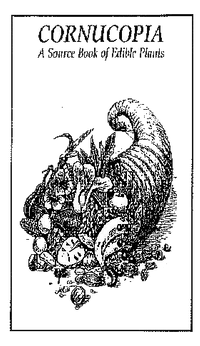 imagine can be found, from vegetables and herbs to rare fruits and edible flowers. There are 226 pages of botanical listings by family (including fungi, algae, and bacteria) followed by 308 pages of cultivar listings, and 53 pages of sources. Then there's nearly 100 pages of useful information in the indices and appendices (vernacular names, uses of edible parts, families and genera, etc.).
imagine can be found, from vegetables and herbs to rare fruits and edible flowers. There are 226 pages of botanical listings by family (including fungi, algae, and bacteria) followed by 308 pages of cultivar listings, and 53 pages of sources. Then there's nearly 100 pages of useful information in the indices and appendices (vernacular names, uses of edible parts, families and genera, etc.).
Let's say we are looking for quinoa. The index of vernacular names tells us the Latin name is Chenopodium quinoa. The index of families and genera tells us that Chenopodium is found on page 66. On page 67 quinoa is listed as follows: "Chenopodium quinoa--Quinoa, Petty rice {S} The nutritious seeds are used in soups, stews, breads, biscuits, cakes, cereals, and pasta, or made into tempeh and chicha. Young leaves can be used like spinach. Sprouted seeds are eaten in salads. An alkaline ash from the burned stems is chewed with coca leaf. Andean South America, cultivated." This entry is followed by 2 references and 13 different sources, both for seed (planting) and grain (eating). We are then referred to page 460 for information on cultivars (23 listed with descriptions and sources) and page 485 for specific information on methods of sprouting quinoa seeds.
The book is a wealth of information. Prices including postage are $37.75 US; overseas $40.25 surface and about $56 airmail. Order from Kampong Publications, 1870 Sunrise Drive, Vista, CA 92084, USA. (See the chapter on Multipurpose Trees for details on a similar sourcebook for multipurpose trees and inoculants.)
 ARE FREE SEEDS A GOOD IDEA? We frequently get letters lamenting that gardeners cannot obtain vegetable seed. Dr. Henry Munger at Cornell University told me that a seed company tried to get started in the Philippines some years ago. About the same time both a U.S. agency and Mrs. Marcos began a free seed distribution program. He believes this put the company out of business. The donors soon tired of giving away seeds, leaving the people with no place to buy them.
ARE FREE SEEDS A GOOD IDEA? We frequently get letters lamenting that gardeners cannot obtain vegetable seed. Dr. Henry Munger at Cornell University told me that a seed company tried to get started in the Philippines some years ago. About the same time both a U.S. agency and Mrs. Marcos began a free seed distribution program. He believes this put the company out of business. The donors soon tired of giving away seeds, leaving the people with no place to buy them.
The owner of a small seed store in a tropical country told me there was an onion seed shortage in his region the year I visited him. He had used his hard-earned foreign exchange to import onion seed the previous year. Then one day a nearby mission began selling onion seed at much below wholesale price, as someone had given them the seed. The next year the seedsman was wise enough not to get caught with onion seed again, but the mission did not give away seed that year. Consequently there was a shortage of seed for one of the major crops of the region.
With very few exceptions, farmers can save their own seed from plants grown from the kind of seed that ECHO provides. In the long run, it is much more helpful to enable local people to take care of themselves than to bail them out sporadically with gifts. This is the ministry that ECHO is continuing and expanding. Development is more lasting than relief.
SEEDS FOR THE AMERICAS sends garden seeds to participating agencies throughout Latin America and the Caribbean (please only write if you are in these areas). End users might include needy individual families, orphanages, schools, churches, 4H clubs, community groups, prisons, etc. One unit of 1,400 packets of seeds normally include 12 kinds of vegetable and two kinds of flower seeds for each garden, packed 100 packets of each seed per bag. The quality of the seed is checked by Mississippi State University before packing. They charge 3› per package to help defray costs.
I asked whether seeds were selected for various micro-climates. "The seed we distribute is very well received, but has not been tested in all the microclimates in which they may be used. In many cases the varieties/hybrids are superior to what is available locally. Seeds distributed in the program are for vegetables that are normally grown and have proven successful in many places in Latin America and the Caribbean." If your organization is interested, contact John Batcha for further details: 4947 Foxbriar Trail, Charlotte, NC 28269, USA; phone/fax 704/597-7789; e-mail GGFG89A@ prodigy.com. This is one resource for those situations in which supplying free seeds to gardeners may be appropriate. But please also consider the following issues.
Some words of caution. Though such seeds can be a blessing, you need to be aware of certain pitfalls. If your idea is to just request seeds and then give them out, please don't.
1. This is old seed, and it might not germinate. ECHO has planted seeds that were donated to us. Most of the time, the results are excellent. But every so often we have done the work of preparing the soil, planting and watering only to find that the seed was dead. That is frustrating to anyone--and can quickly ruin your credibility. Damage can be even worse. If there is a short period during which gardens must be planted, there might be no time left for replanting. Your effort to save them the cost of seed may have lost them their entire harvest.
I would absolutely never distribute free seed to farmers unless I had tested its viability first. Just plant a few seeds from a 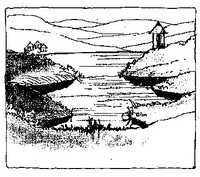 packet or two of each variety near your home and see what percent comes up. There is no need to use normal spacing, as this is just a test. Perhaps 50 seeds half an inch apart would suffice. Not all packets of a particular vegetable may be good; some may have been in a store without air conditioning. One way to make sure that the occasional farmer does not get one of these bad packets is to open every packet of that species, mix thoroughly, and check viability in bulk. If it is acceptable, repackage in some manner.
packet or two of each variety near your home and see what percent comes up. There is no need to use normal spacing, as this is just a test. Perhaps 50 seeds half an inch apart would suffice. Not all packets of a particular vegetable may be good; some may have been in a store without air conditioning. One way to make sure that the occasional farmer does not get one of these bad packets is to open every packet of that species, mix thoroughly, and check viability in bulk. If it is acceptable, repackage in some manner.
2. The seed may be good, but the vegetable will not grow in your location. If farmers or gardeners in your area are used to and fond of the idea of experimenting, they may enjoy finding out. Others may lose interest very quickly. Except to such experimenters, I would never give out seed for a vegetable I had not grown myself or seen grown in the community. (If your climate is mild due to high elevation and rainfall is uniform, there is a good chance that most temperate vegetables will grow. If you are in the hot lowlands, many will not.)
3. Only some varieties of a vegetable may be adapted to your area. For example, varieties may differ in susceptibility to disease. Most varieties of cucumber will not produce here in our hot, humid summers, but the 'Poinsette' variety does give some fruit. Be especially wary of onion seeds. Only seeds marked "short day onions" have any chance of forming bulbs in the short days found in the tropics and subtropics. Others will produce leaves and stems for green onions.
4. You can disrupt local businesses, as in the article above. Any retailers who may be selling seeds in your community provide an essential service. If you distribute free seeds on any substantial scale to people who normally buy from a local business, they may stop carrying seed or reduce inventory. What will farmers do in a year or two when you are on furlough for a year or distributing seeds is no longer a priority for you?
5. The seed may be a hybrid. For many vegetables, seed saved from hybrid plants gives unpredictable results and often inferior plants. If farmers do not save their own seed, hybrid seed might be preferred. But if some farmers save their own seed for the next season, they may be hurt next year and you may not even know you caused it.
SAVING SEEDS FROM HYBRIDS? [The following is based on an article in International Agricultural Development July/August 1994.] Research aimed at transferring the "apomixis" gene from a wild grass into rice could result in farmers being able to save seed year after year from hybrid plants. Normally the special traits that cause farmers to purchase hybrid seeds are lost if seed from that crop are saved and planted and yields may be low and unreliable. "Plants with the apomixis gene are able to reproduce asexually through their own seeds" (i.e. without cross-pollination). So these seeds would be identical to the original hybrid seed. "Although the apomixis gene occurs in around 300 wild plants, it is rare in crops of economic importance. Wild plants are so different that scientists have had little success in transferring their genes into domesticated crops."
Scientists at CIAT in Colombia have identified "markers" for apomixis in a grass called brachiaria and confirmed that in this grass a single dominant gene controls apomixis ("This is a little like finding the road signs"). When the gene is found, the next step is to clone it into unrelated crops. "Cloning may take 3-5 years."
BAMBOO BREEDING. Have you ever thought how frustrating it would be to be a graduate student in plant breeding studying bamboo? You could only make the crosses between varieties when they flowered. In bamboo, flowering occurs most commonly after 30 years, but can be on other multiples of 15, even 120 years for different species. Then there is the problem that the two varieties you wanted to cross might not flower at the same time. That is why this terribly important plant has never been improved by plant breeding.
Dr. Larry Butler at Purdue University alerted us to a breakthrough (Nature, vol. 344, p 291, 1990). Researchers have found that "tissue cultured shoots from bamboo seedlings on medium supplemented with cytokinin [a plant hormone] and coconut milk flowered ... after only three subcultures." The varieties they work with would normally flower after 30 years. Similar advances have been found with other species. For example, date palm shoots can be made to flower in five months after tissue culture rather than the usual 9 years.
There should now be "an explosion of new types [of bamboo]...". There is plenty of variation to chose from in making crosses. "Leaves, for example, vary between species from great sheets 4.l5 meters long and 30 centimeters wide (on a plant only 3 meters high) to hair-like threads." "Bamboo hay has four times the protein content of hay from grasses and paper from bamboo is much better than newsprint."
WHERE CAN I FIND SEED FOR BREADFRUIT? We were recently asked that question. Actually breadfruit does not produce seed. It must be propagated asexually. On a recent trip to Malaysia, however, I learned from Dr. Lee Ming Yong at the Tenom Agricultural Experiment Station that they are able to V-graft breadfruit onto breadnut trees. The breadnut has a lot of seeds.
HOW TO PRODUCE CARROT SEED WHERE WINTERS ARE NOT COLD. We often hear from people in our network who want to do gardening projects, but who are frustrated because seeds are not available in local stores or people cannot  afford the seeds.
afford the seeds.
We have become so dependent on seed companies that we forget they have only been around a century or so. Except for situations where weather interferes with the harvest, there should be no need to purchase seed for any non-hybrid vegetable that produces seed in your garden. Just save your own seed. (Seeds saved from hybrid plants usually give unsatisfactory results, which is why we do not recommend hybrid plants for most situations. Because it is difficult to tell if a seed-containing vegetable in the local market has been grown from hybrid seed, it is safer to start with known non-hybrid seed. On the other hand, local produce may have been grown from especially well adapted varieties passed on from generation to generation, so it may be worth a try.)
There is a tendency for people who grew up in temperate climates to think only of vegetables that were popular there. Do not forget that the bulk of vegetables in a tropical garden should probably be what I refer to as "plants that God created for that climate." However, the temperate vegetables are good and often bring premium prices if a way can be found to obtain seed and to grow them.
Not every temperate vegetable will produce seeds in the tropics. If the following grow in your community, you should have no problem saving your own seed: pumpkins, squash, eggplant, cucumber, lettuce, peppers, corn, radish, or tomato. You will probably need to purchase onion, leek, carrot, kale, beet, and cabbage seed. However, if you are willing to do some extra work, there is a way to produce carrot seed in most climates where carrots will grow. [ECHO has seed of the Uberlandia carrot which produces seed in one season in the tropics. However, this carrot is presently not selected enough to be of immediate commercial value: there is much variation in the carrots and the quality is generally lower than commercial carrot varieties.] The Beta III carrot from ECHO is not a hybrid, so you can use it to produce your own seed. The following is abstracted from a bulletin provided by Dr. Simon, who works extensively with carrots.
Carrots do not produce seed in the tropics because they are biennials. Carrots need two growing seasons with a period of cold (vernalization) in between. To produce seed, first grow plants and harvest roots as you normally would. Discard or eat any that are not "ideal" carrots. Pencil-sized roots will do, but larger roots are preferable.
Trim the tops back to 2-4 cm, trim off lateral and fibrous roots, gently wash off the soil, and remove any yellowing leaves. Let the carrots dry on a shelf out of the sun until no surface moisture remains, pack in paper bags with an equal volume of wood shavings, and place in closed polyethylene bags in the refrigerator (2-5 deg.C). After several weeks when water droplets accumulate inside the plastic bags, puncture the bags.
Even with all these precautions, carrots are very susceptible to infection during storage. In commercial production the roots are dipped in fungicide before vernalization, but this is dangerous unless you are CERTAIN that no one will be tempted to eat the carrots.
The next season plant the vernalized roots, taking care to keep them well-watered but not in standing water. Seed stalk development will be evident in 4 to 6 weeks. It is very difficult to produce carrot seed where warm humid climates favor microbial growth. Control of fungal diseases and insect pests is essential. If the wild carrot, queen anne's lace, grows nearby, it will cross and yield white-rooted plants.
Pollination is by bees or flies. Alternatively, pollen movement is possible by hand or brush, but seed set will often be low. Within 4-6 weeks after pollination the developing seed turns brown. Before the seed shatters, harvest and place into paper bags to dry completely. If rains occur just before harvest, the yield of seed can be reduced drastically. Perhaps you can adjust planting time to increase the likelihood of dry weather while seeds are ripening. Remove spines from dry seed by rubbing. Because carrot seed requires no dormant period, the seed is now ready to plant. Store dry seed in a moisture-proof container in a refrigerator if possible.
HOW FAR APART MUST CORN BE KEPT TO PREVENT CROSS-POLLINATION BY OTHER LOCAL VARIETIES? Ray Vander Zaag in Haiti asked this question because he wanted to increase seed for the high lysine corn. I referred to Agricultural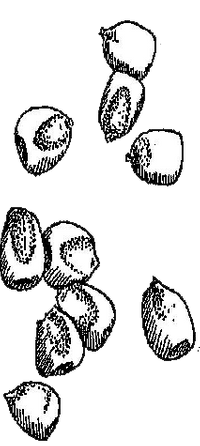 and Horticultural Seeds for the following summary. Because corn is pollinated by the wind, a considerable distance is required to eliminate the possibility of cross-pollination. In U.S. seed production, different varieties are isolated at least 180 meters, though the distance depends on normal wind velocity in the area. In South Africa varieties are kept 360-740 meters apart.
and Horticultural Seeds for the following summary. Because corn is pollinated by the wind, a considerable distance is required to eliminate the possibility of cross-pollination. In U.S. seed production, different varieties are isolated at least 180 meters, though the distance depends on normal wind velocity in the area. In South Africa varieties are kept 360-740 meters apart.
Natural barriers such as tall trees are useful, and give extra safety in case of very strong winds. Often several rows of the same variety are planted around the field as "border rows." The seed from these border rows are used as food, but not saved for seed. A good general practice would be to harvest seed from the interior parts of the field if neighboring farmers are growing other varieties of corn.
If the ideal distance cannot be maintained, you can reduce the required distance by either (1) increasing the size of your field or (2) planting several border rows. For example, a 16 hectare field requires 165 meters separation from other varieties and a 4 hectare field 200 meters. The effect of having several border rows can be dramatic. The same 16 and 4 hectare fields with 13 border rows require only 15 and 50 meters separation, respectively.
GROWING GARLIC. Why is garlic grown using vegetative material rather than seeds? The Asian Vegetable Research and Development Center (AVRDC) publication Centerpoint says it is because of sterility in garlic. This limits scientists' ability to improve the plant as well. Recently AVRDC scientist Dr. C. S. Pathak found garlic clones that flower. So far, eight clones of this flowering type have been collected in Taiwan, but pollen fertility was noted in only one. Hand-pollination resulted in excellent fruit development with healthy embryos. "This points to the possibility of seed production in tropical garlic."
Laura Raab wrote from Kenya: "Some time ago I asked you how to get garlic to sprout and you referred me to Dr. Pathak with AVRDC in Taiwan. His answer is so simple that I thought it might benefit others. He said that the problem in sprouting garlic cloves may not be dependent only on temperature. The age of the bulb is equally important. If bulbs are freshly harvested, it is very difficult to get them sprouted. Bulbs which have been stored for 3-4 months will easily sprout once you put them in soil."
SAVING YOUR OWN LETTUCE SEED. Beth Adams and Mike Fennema in Haiti had decent production with three varieties of lettuce, but some started to go to seed. They asked whether they needed to be concerned about cross-pollination between varieties and for suggestions on harvesting. A frequent problem with lettuce in the tropics, or during hot weather anywhere, is that the plants quickly bolt (send up seed stalks). That is actually good news for seed production, as long as rainfall and humidity are not so high that the seeds are damaged. If the variety performed reasonably well for you, and was not a hybrid, it should not be difficult to save your own seed. The following is excerpted from Agricultural and Horticultural Seeds.
Lettuce is mainly self-pollinated, but there can be 1-6% cross-pollination by insects. For pure seed production different varieties should be isolated by at least 30-60 meters OR separated 2-4 meters by a thick fence or tall- growing crop. The seed stalk may not be able to emerge from varieties with compact heads. In such cases the heads can be removed or cut in quarters with a sharp knife when mature.
Seed ripens unevenly and fully mature seed shatters readily. For large scale seed production it is advisable to harvest when 30-50% of the seeds in heads show white fluff. Heads are left on the ground for a few days to dry. In the U.S.A. plants are cut and windrowed when most flower heads are still yellow, and left to dry. These are later harvested with a combine. For hand harvesting, people either pick individual flower heads as they ripen or bend plants into a large bag and shake gently to remove ripe seed.
ECHO intern Karen Ebey found an easy way to separate the tiny black seeds of lettuce from the fluffy material to which they are attached. She placed the freshly harvested material in a cup and stirred briskly with a fork. The seeds quickly settled to the bottom. Seeds can be stored up to six years in a cool, dry place. In the tropics it can be stored in airtight containers for six months if thoroughly dried first to a moisture content of 8-10%.
ONION VARIETY TRIAL. Dr. Lesley Currah has put together seed for a large onion variety trial that she sends to researchers around the world. Most members of ECHO's network would not have the resources to qualify to participate in such a large trial. However, she has sent one trial for ECHO to subdivide and make mini-trials available to you. We divided them into sets of six varieties each. We will send two sets at no charge to development workers assisting peasant farmers or to university researchers. When you report the results you can request another set. She asks that you be sure to include the best local varieties in your trial for comparison.
Dr. Currah is interested in learning how the onions grown from these seeds perform in many different environments. If you are willing to take some careful data, indicate this in your letter. We will then send some special report forms that she has provided, rather than ECHO's general forms. Formal researchers who need both more varieties and more seeds of each, write to Dr. Currah directly to inquire about joining her onion research network: Horticulture Research International, Wellesbourne, Warwick CV35 9EF, UK; fax 0789-470552.
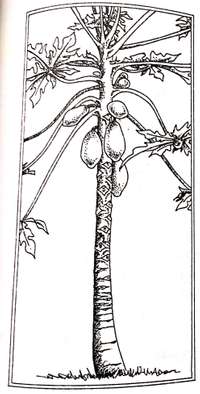 THE SOLO PAPAYAS ARE GREAT, BUT... We received a request from Honduras wanting to know where they could purchase several pounds of solo papaya seeds. Solo papayas have two (at least) special characteristics: (1) Each tree produces fruit, so you do not have to worry about whether a tree is a male or female and (2) the fruit are grapefruit-sized, about the right size for one meal and by far the most popular size in the U.S. market.
THE SOLO PAPAYAS ARE GREAT, BUT... We received a request from Honduras wanting to know where they could purchase several pounds of solo papaya seeds. Solo papayas have two (at least) special characteristics: (1) Each tree produces fruit, so you do not have to worry about whether a tree is a male or female and (2) the fruit are grapefruit-sized, about the right size for one meal and by far the most popular size in the U.S. market.
I understand the urgency to grow something on a large scale and take advantage of an export market. However, as a scientist I am always cautious about doing anything on a large scale until the new species or variety has been tried under local conditions. The solo papaya is at special risk, including the definite possibility of a serious crop failure. Though a failure might not occur right away, it would always be a threat. I called Dr. Carl Campbell at the University of Florida experiment station for more details.
Dr. Campbell said that papaya ring spot disease is a serious problem here in Florida and is definitely present in Honduras. Because the solo types are so popular on the export market, people are planting them in the Caribbean in spite of the threat of disease, but may have to cut them down and replant every year or two. They apparently think the superior market price is worth it.
There is a resistant variety, however, called the Cariflora. It was developed at the experiment station in Florida. Dr. List, the man in charge of this research, said there is heavy disease pressure in Central America, both with the ring spot and a couple other viruses. Solo papayas do not do well there at all. He has only seen virus-free solo papayas in one location in Central America (in Costa Rica). He felt our friend would probably not even get a crop. One man in Costa Rica who tried many varieties had to cut down the solo varieties without a harvest.
Because these virus diseases seem to attack cucurbits (e.g. cucumber), it may be difficult to grow solo papayas if there are serious cucurbit virus diseases in the area. Ordinary solo papayas have been taken out of production now in Taiwan. They currently grow only the Cariflora. It is about grapefruit size, neither as small nor as sweet as the solo. However, it is close to the general size demanded in U.S. markets. ECHO has a small quantity of seed in our seedbank to share with people overseas. By the way, the regular solo papayas do great for us here in southwest Florida and just might for you as well. You can order seed inexpensively from the Seed Program, Dept. of Horticulture, University of Hawaii, 3190 Maile Way, Room 112, Honolulu, Hawaii, 96822, USA.
MALAYSIA EXOTICA PAPAYA (Overseas network only). I toured agricultural research stations in Malaysia with a group. I especially enjoyed the papaya we were served by Dr. Tony Lamb at the Tenom Agriculture Experiment Station.
The "solo" sunrise papaya from Hawaii that is so successful commercially does not do exceptionally well in Malaysia. (It also does not do well in many parts of Central America and the Caribbean, where it is badly affected by virus diseases.) However, the solo has many positive characteristics. Every tree will bear fruit, in contrast with most papayas for which half of the trees are males which bear nothing. The fruit is small enough (grapefruit size) that the entire fruit can be used without the need to store leftovers. The flavor is good and there is no objectionable smell.
So the sunrise solo was crossed with suban, a local Malaysian papaya, then 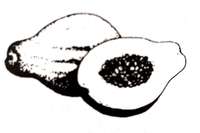 backcrossed again to solo. The resulting fruits have a deep orange color and great taste and smell. The trees are better adapted to the heat and other conditions in Malaysia.
backcrossed again to solo. The resulting fruits have a deep orange color and great taste and smell. The trees are better adapted to the heat and other conditions in Malaysia.
We can share some small packets with our network. If they do well for you, you can keep the line pure by harvesting seed only from the hermaphroditic fruit (same flower has both male and female parts). Dr. Lamb said that if you plant seed from a hermaphroditic papaya, 1/3 of the trees will be female (F) and 2/3 will be hermaphroditic (H). (Half of the trees grown from seeds of female solo trees pollinated by solo trees will be 1/2 F and 1/2 H. Trees grown from seeds of a female solo pollinated by a male tree will be 1/3 each H, F, and M.) At the research station trees are marked either F or H, then seed is saved only from the H trees. Hermaphroditic fruits bring a better price too. They are oblong with a small seed cavity compared to fruits of female trees which are round with a large seed cavity.
WHY IS THERE SUCH HIGH TURNOVER IN THE TREE SEED BUSINESS? Starting a tree seed company would be one of my last choices if my goal were to make money. The reasons for my opinion may also explain why there are so few companies that specialize in this for a long period of time.
The market for seed of a particular tree is impossible to predict. Much depends on what publicity that tree has recently received or what the latest research results have been. In a given year, one group may receive a grant to do a large project and decide to order a large quantity of seed for a particular tree--but perhaps no other group in the world is making a large planting of that tree that year. The storage life of tree seeds ranges from a few weeks to years, and in some cases no one even knows.
About the only way to keep the company's inventory under control and still assure the customer of quality seed is to collect seed after receiving the order. This is the policy of many companies, so do not be surprised if you cannot just mail off a check and receive seed in a few weeks. Especially if you have a large project, be prepared to make your order months ahead of the time you will need the seed. If seed comes from stock on hand, be sure to ask when it was harvested, how it was stored, and the life expectancy of the seed.
ROY DANFORTH AND PAUL NOREN'S TROPICAL FRUIT TREE PROJECT IN ZAIRE. [Excerpted from their December 1990 "Zaire Rare Fruit Newsletter."] The agroforestry project has suddenly captured the interest of the Zairians like never before! Nurseries have been established in selected villages for a faster method of fruit tree distribution. This has proven very successful as many of these villages have trees planted every-where: people's yards, school or church yards, etc. They cannot keep up with the demand. The interest in fruit trees is on the rise because food is more scarce, because some of the trees are starting to fruit, and the growers really enjoy the new tastes! Rollinias, jackfruits, star apples and canistels are coming into production and are immediately becoming favorites with the Zairian people.
Seed is available on an exchange basis [though it is hard to imagine that anyone would have something that Roy and Paul still need!] or payment of one U.S. dollar per small packet. [Ed: I'm sure they will lose money at $1 per packet, so be generous if you can. ECHO seeks special funding to give things to our network, but Roy is one of you, which means that his funding is for work in his community.]
I am taking the liberty of listing just a few of the trees for which he is offering seed. The number(s) in parenthesis show the month(s) during which seed can typically be collected; e.g. (12-3) means December through March. Get orders in early so they can plan to collect what you need. His list contains many, many more trees that are not yet fruiting, that are lesser known or that are reforestation species. To get a copy of his list, write Roy Danforth, B.P. 1377, Bangui, CENTRAL AFRICAN REPUBLIC.
Achras sapota, Sapodilla (4); Adansonia digitata, Baobob (8); Anacardium occidentale, Cashew (12-3); Artocarpus altilis, Breadnut (most); Artocarpus 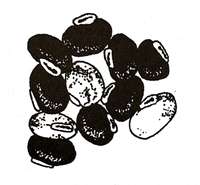 heterophyllus, Jackfruit (most); Averrhoa carambola, Carambola (most); Cinnamomum zeylandicum, Cinnamon (rare); Coffea spp. (liberica), coffee (1-2); Coffea robusta, Coffee (10 & 1-2); Coffea arabica, C. arabica x C. robusta, Coffee (most); Cola acuminata, kola nut (most); Elaeis guineensis, Oil palm (most); Eriobotrya japonica, Loquat (8); Garcinia livingstoneii, Imbe (all); Garcinia mangostana, Mangosteen (7,8); Macadamia tetraphylla, Macadamia (1-2); Morus indica, Mulberry (most); Muntingia calabura, Strawberry tree (most); Murraya koenigii, Curryleaf tree (most); Nephelium lappaceum, Rambutan (8-9); Passiflora spp., passion fruit (most); Pouteria caimito, Abiu (6); Psidium spp., Guava spp. (8); Theobroma cacao, Cocoa (8-12); Treculia africana, African breadnut (8); Zizyphus mauritiana, Indian jujube (8).
heterophyllus, Jackfruit (most); Averrhoa carambola, Carambola (most); Cinnamomum zeylandicum, Cinnamon (rare); Coffea spp. (liberica), coffee (1-2); Coffea robusta, Coffee (10 & 1-2); Coffea arabica, C. arabica x C. robusta, Coffee (most); Cola acuminata, kola nut (most); Elaeis guineensis, Oil palm (most); Eriobotrya japonica, Loquat (8); Garcinia livingstoneii, Imbe (all); Garcinia mangostana, Mangosteen (7,8); Macadamia tetraphylla, Macadamia (1-2); Morus indica, Mulberry (most); Muntingia calabura, Strawberry tree (most); Murraya koenigii, Curryleaf tree (most); Nephelium lappaceum, Rambutan (8-9); Passiflora spp., passion fruit (most); Pouteria caimito, Abiu (6); Psidium spp., Guava spp. (8); Theobroma cacao, Cocoa (8-12); Treculia africana, African breadnut (8); Zizyphus mauritiana, Indian jujube (8).
MORE SEED SOURCES. It is very difficult to keep current information about seed companies. Unless they regularly send us new catalogs, we cannot be sure they are still in business or in the same location. We appreciate it when our network lets us know of their experiences with buying seed or plants: reasonable prices, helpful service, prompt delivery, quality of the plants, etc. If you try to contact a company listed here without success, please let us know that as well. The following list includes the most current information we have on seed or plant suppliers. If you cannot find sources of the seed you need through these groups, we can try to locate another source for you. Continue to let us know of more sources.
Wide selection and vegetables. The Inland & Foreign Trading Co. (Block 79A, 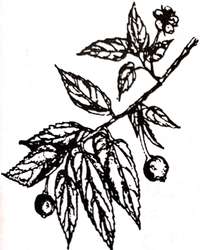 Indus Road #04-418/420, Singapore 0316; phone 2722711; fax 2716118) is an excellent source of leguminous cover crop and pasture species (specialty), fruit trees, ornamental and flowering trees, and more. J.L. Hudson, Seedsman (Star Route 2, Box 337, La Honda, CA 94020, USA) offers a tremendous variety of seeds in the "Ethnobotanical Catalog of Seeds," including agroforestry species, unusual vegetables, flowers and ornamentals, and plants used medicinally, in small packets and at very reasonable prices. Seed Savers Exchange (3076 North Winn Rd., Decorah, IA 52101, USA) members maintain a tremendous variety of rare heirloom vegetable, herb, fruit, and other seeds. Native Seeds/SEARCH (2509 N. Campbell Ave. #325, Tucson, AZ 85719, USA; phone 520/327-9123; fax 520/327-5821) offers a 50% discount to native peoples on their tremendous selection of amaranth, beans, chili peppers, corn, cucurbits, okra, tomatoes, flowers, and more, suitable for very hot and dry conditions; some are adapted to higher altitudes as well. High Altitude Gardens (P.O. Box 1048, Hailey, ID 83333, USA; phone 208/788-4363; fax 208/788-3452; e-mail higarden@micron.net) specializes in frost-tolerant, quick-maturing varieties for cold climates; their catalog lists over 300 varieties of vegetables, plus herbs, wildflowers, and grasses. The University of Hawaii (Seed Program, Department of Horticulture, 3190 Maile Way, Room 112, Honolulu, HI 96822, USA; they only ship to US addresses; phone 808/956-7890) offers high-quality seed of select varieties of solo papaya, pole bean, lettuce, sweet corn, eggplant, tomato, and other vegetables. Shivalik Seeds Corporation (47, Panditwari, P.O. Premnagar, Dehra Dun-248 007 (U.P.), INDIA; phone 91-135-683 348; fax 91-135-29944) offers seeds of a wide range of (agro)forestry, medicinal, horticultural, ornamental plants. CIMMYT (Centro Internacional de Mejoramiento de Ma¡z y Trigo, Lisboa 27, Apartado Postal 6-641, 06600, MEXICO D.F.) has improved varieties of corn and wheat, including Quality Protein Maize. Plants of the Southwest (Agua Fria, Rt. 6 Box 11-A, Santa Fe, NM 87505, USA; phone 505/471-2212; fax 505/438-8800) has corn, cover crops and vegetables for arid gardens. Richters Herb Specialists (Goodwood, Ontario LOC 1AO, CANADA; phone 905/640-6677; fax -6641; e-mail orderdesk@richters.com) has a very complete herb listing. Tomato Growers Supply Co. (P.O. Box 2237, Fort Myers, FL 33902, USA; phone 239/768-1119; fax -3476) has a huge selection of tomato and pepper varieties. Twilley Seed Co. (P.O. Box 65, Trevose, PA 19053, USA) has common temperate vegetable and flower seeds. Pax World Service compiled a list of 36 non-profit international seed distributors in 1996; write them at 1111 16th St., NW, Suite 120, Washington, D.C. 20036, USA; phone 202/293-7290; fax 202/293-7023; e-mail paxwldsvc@aol.com; web site http://members.aol.com/paxwldsvc.
Indus Road #04-418/420, Singapore 0316; phone 2722711; fax 2716118) is an excellent source of leguminous cover crop and pasture species (specialty), fruit trees, ornamental and flowering trees, and more. J.L. Hudson, Seedsman (Star Route 2, Box 337, La Honda, CA 94020, USA) offers a tremendous variety of seeds in the "Ethnobotanical Catalog of Seeds," including agroforestry species, unusual vegetables, flowers and ornamentals, and plants used medicinally, in small packets and at very reasonable prices. Seed Savers Exchange (3076 North Winn Rd., Decorah, IA 52101, USA) members maintain a tremendous variety of rare heirloom vegetable, herb, fruit, and other seeds. Native Seeds/SEARCH (2509 N. Campbell Ave. #325, Tucson, AZ 85719, USA; phone 520/327-9123; fax 520/327-5821) offers a 50% discount to native peoples on their tremendous selection of amaranth, beans, chili peppers, corn, cucurbits, okra, tomatoes, flowers, and more, suitable for very hot and dry conditions; some are adapted to higher altitudes as well. High Altitude Gardens (P.O. Box 1048, Hailey, ID 83333, USA; phone 208/788-4363; fax 208/788-3452; e-mail higarden@micron.net) specializes in frost-tolerant, quick-maturing varieties for cold climates; their catalog lists over 300 varieties of vegetables, plus herbs, wildflowers, and grasses. The University of Hawaii (Seed Program, Department of Horticulture, 3190 Maile Way, Room 112, Honolulu, HI 96822, USA; they only ship to US addresses; phone 808/956-7890) offers high-quality seed of select varieties of solo papaya, pole bean, lettuce, sweet corn, eggplant, tomato, and other vegetables. Shivalik Seeds Corporation (47, Panditwari, P.O. Premnagar, Dehra Dun-248 007 (U.P.), INDIA; phone 91-135-683 348; fax 91-135-29944) offers seeds of a wide range of (agro)forestry, medicinal, horticultural, ornamental plants. CIMMYT (Centro Internacional de Mejoramiento de Ma¡z y Trigo, Lisboa 27, Apartado Postal 6-641, 06600, MEXICO D.F.) has improved varieties of corn and wheat, including Quality Protein Maize. Plants of the Southwest (Agua Fria, Rt. 6 Box 11-A, Santa Fe, NM 87505, USA; phone 505/471-2212; fax 505/438-8800) has corn, cover crops and vegetables for arid gardens. Richters Herb Specialists (Goodwood, Ontario LOC 1AO, CANADA; phone 905/640-6677; fax -6641; e-mail orderdesk@richters.com) has a very complete herb listing. Tomato Growers Supply Co. (P.O. Box 2237, Fort Myers, FL 33902, USA; phone 239/768-1119; fax -3476) has a huge selection of tomato and pepper varieties. Twilley Seed Co. (P.O. Box 65, Trevose, PA 19053, USA) has common temperate vegetable and flower seeds. Pax World Service compiled a list of 36 non-profit international seed distributors in 1996; write them at 1111 16th St., NW, Suite 120, Washington, D.C. 20036, USA; phone 202/293-7290; fax 202/293-7023; e-mail paxwldsvc@aol.com; web site http://members.aol.com/paxwldsvc.
Fruit trees. ECHO has an Edible Landscape Nursery, which includes many varieties of tropical fruits. ECHO does not ship plants at all, but if you visit us en route overseas, you might be able to take a few plants or cuttings with you. The Pacific Tree Farms (4301 Lynwood Drive; Chula Vista, CA 91910, USA; phone 619/422-2400) has quite a listing of grafted or air-layered tropical fruit trees, NOT SEEDS, for sale. They are expensive (average US$38). However, if you want one tree of a particular variety to provide you with budwood in a year or two, they may be the answer. They will ship overseas, but that will be expensive too. The Chestnut Hill Nursery (Rt. 1, Box 341, Alachua, FL 32615, USA; phone 800/669-2067 or 904/462-2820; fax 904/462-4330) specializes in chestnuts, persimmons, and temperate/subtropical fruits (apple, pear, peach, fig, grapes, blueberry, citrus, berries, etc.) and nuts at reasonable prices. Peter B. Dow & Co. (P.O. Box 696, Gisborne 3800, NEW ZEALAND) is listed in Cornucopia as a source of fruit tree seeds. Fruit Spirit Botanical Gardens (Dorroughby, N.S.W., AUSTRALIA 2480; phone 066 895 192) has a very extensive listing of tropical fruits and nuts, gingers, and other plants. Small packets are A$5, and bulk seed is available. The Borneo Collection (Treefarm, El Arish, North Queensland 4855, AUSTRALIA) has South American, Southeast Asian, and Borneo species available seasonally. CATIE (Centro Agronomico Tropical de Investigacion y Ensenanza, BLSF, Turrialba, COSTA RICA) supplies fruit and forest trees.
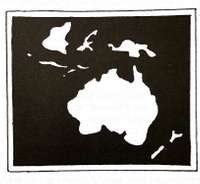 Pasture and/or tree seeds. Samuel Ratnam, the director of The Inland & Foreign Trading Co. (see above), sent us a 2-page listing (prices only upon specific inquiry) of pasture, cover crop and shrub/tree seeds, which they have marketed for 40 years, especially to plantations, ranches and reforestation programs. Many pasture grasses and legumes are available from Frank Sauer and Sons (P.O. Box 117, Rockhampton 4700, Queensland, AUSTRALIA). The Australian Revegetation Corporation (Kimseed; 42 Sarich Court, Osborn Park 6017, Western Australia; phone 09-446-4377; fax 09-446-3444) catalog lists over 200 different species of Acacia, 19 species of Casuarina, over 500 species of Eucalyptus, and much more. Tropical, subtropical and temperate grasses and legumes for pastures and ground covers are also listed; for example, they have 9 species (29 varieties) of Trifolium (clovers) and 9 varieties of Medicago (alfalfa). M.L. Farrar PTY. LTD. (P.O. Box 1046, Bomaderry NSW 2541, AUSTRALIA; phone 044-217966; fax 044-210051) has a huge selection of trees. Agroforester Tropical Seeds (P.O. Box 428, Holualoa, HI 96725, USA; fax 808/324-4129; e-mail agroforester@igc.org) sells seed and also produces Rhizobium inoculants. The Australasian Tree Crops Sourcebook (1994; A$12 from Granny Smith's Bookshop, P.O. Box 27, Subiaco, WA 6008, AUSTRALIA; fax 61-9-385-1612) is full of information on fruit, oil, and nut crops, and organizations of tree crop growers.
Pasture and/or tree seeds. Samuel Ratnam, the director of The Inland & Foreign Trading Co. (see above), sent us a 2-page listing (prices only upon specific inquiry) of pasture, cover crop and shrub/tree seeds, which they have marketed for 40 years, especially to plantations, ranches and reforestation programs. Many pasture grasses and legumes are available from Frank Sauer and Sons (P.O. Box 117, Rockhampton 4700, Queensland, AUSTRALIA). The Australian Revegetation Corporation (Kimseed; 42 Sarich Court, Osborn Park 6017, Western Australia; phone 09-446-4377; fax 09-446-3444) catalog lists over 200 different species of Acacia, 19 species of Casuarina, over 500 species of Eucalyptus, and much more. Tropical, subtropical and temperate grasses and legumes for pastures and ground covers are also listed; for example, they have 9 species (29 varieties) of Trifolium (clovers) and 9 varieties of Medicago (alfalfa). M.L. Farrar PTY. LTD. (P.O. Box 1046, Bomaderry NSW 2541, AUSTRALIA; phone 044-217966; fax 044-210051) has a huge selection of trees. Agroforester Tropical Seeds (P.O. Box 428, Holualoa, HI 96725, USA; fax 808/324-4129; e-mail agroforester@igc.org) sells seed and also produces Rhizobium inoculants. The Australasian Tree Crops Sourcebook (1994; A$12 from Granny Smith's Bookshop, P.O. Box 27, Subiaco, WA 6008, AUSTRALIA; fax 61-9-385-1612) is full of information on fruit, oil, and nut crops, and organizations of tree crop growers.
The Henry Doubleday Research Association (Ryton-on-Dunsmore, Coventry CV8 3LG, UK; phone 01203-303517; fax 01203-639229; e-mail pharris@hdra.demon.co.uk; Attn. Dr. Phil Harris), a registered charity in the United Kingdom, makes available easily understood information and advice on tropical organic agriculture to farmers, NGOs, self-help groups, schools, and other organizations in developing countries, helping them function more effectively in their extension, demonstration, and education roles. The HDRA also assists groups in selecting tree species for their required purposes, providing technical and practical details for their cultivation and use. Where available, they may provide small quantities of tree and shrub seed for local evaluation. Lusume Services (P.O. Box 42, Magoye, ZAMBIA) has a variety of multipurpose and fruit tree seeds at reasonable prices. For the Latin American Bank of Forestry Seeds, write to CATIE Seedbank, Box 111, Turrialba 7170, COSTA RICA. The Endangered Species (P.O. Box 1830, Tustin, CA 92680, USA; phone 714/544-9505; fax 714/669-0740) catalog lists 140 kinds of bamboo and 105 palms (plants only). SETROPA (P.O. Box 203, 1400 AE Bussom, HOLLAND; phone 31/2152-58754; fax 31/2152-65424) has many tree seeds, with some legumes and grasses. Green Gold International (14071, Street 5, Prabhat Nagar, Dholewal, Ludhiana-114 003, INDIA; phone 91-1662-32326; fax 91-161-401513 or 91-1662-32120) specializes in seed and wax-sealed cuttings of neem; about 300 tree species are in their catalog.
Dr. Jean Hanson, head of ILCA's Forage Genetic Resources Section wrote, "The ILCA genebank holds about 12,000 accessions of a wide range of forage legumes, grass and fodder tree species. Small experimental quantities of seeds are available free of charge for forage research and development workers. It usually takes up to a month to fill seed requests." For large projects, they publish a catalogue in 3 volumes. Volume 1: multipurpose trees and large shrubs; Volume 2: tropical lowland forages; Volume 3: temperate and tropical highland forages. "ILCA also has a Herbage Seed Unit that can provide larger quantities of a limited range of species to begin local forage seed multiplication programmes. You may wish to mention our service in your newsletter so that readers can write to request seeds." We have always found the people at ILCA to be very responsive and open to helping development workers. If you are having trouble finding something, keep them in mind. (Note: in 1996, ILCA merged with ILRAD-Kenya to form ILRI, the International Livestock Research Institute. We hope these same services are still available. The address is P.O. Box 5689, Addis Ababa, ETHIOPIA.)
If you still cannot find what you want, the FACT Net (see Chapter 4 on Multipurpose Trees) has addresses of other commercial tree seed companies, including a two-page listing of tree seed companies in the Pacific. Remember to order well in advance of planting date, because tree seed companies often must fill orders from the next harvest.